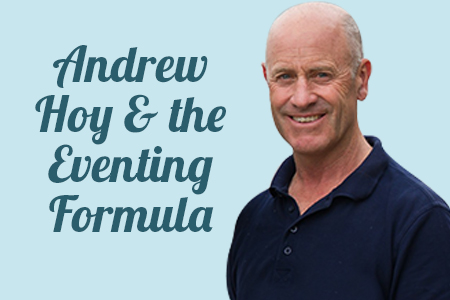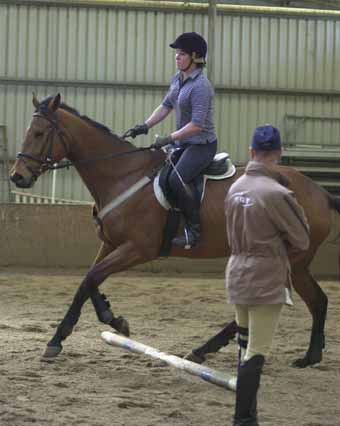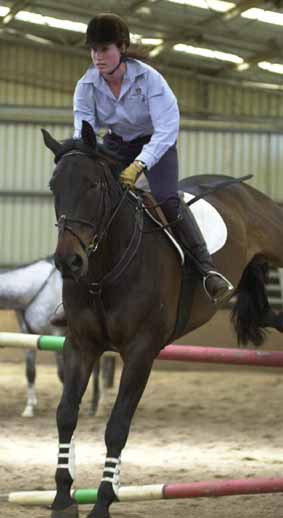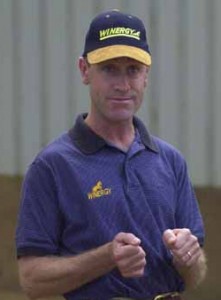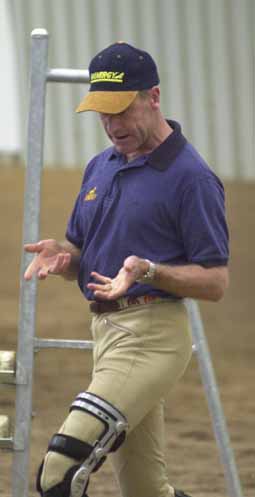Words and photos – Roz Neave
All these event riders were dying to get out on the cross country training course at Marcus Oldham College, but Andrew Hoy had other ideas. After lunch the second group was off to the indoor arena for a session on polishing up rider position and more pearls of wisdom on how to train an event horse.
“To start with we are going to warm up over the poles, then we are going to ride some lines. The contact with the outside rein is the important thing. As you circle, it’s the change of the bend coming to the pole, before you get there establish contact with the new outside rein and use your leg as you get to the pole.”
“Pole work is a very simple exercise but it has to be executed correctly for it to work, and then that also helps you for the dressage arena, because it teaches you the formula.”
One rider had a big rangy young horse travelling a bit long and on the forehand…
“It is okay warming the horse up round and low, but you also need to be able to ride them up. The coming-up-in-front needs to come from the rider’s leg – it’s got to come from the leg first. That is what you see with so many riders, it doesn’t come from the leg, it comes from the hand so the horse doesn’t stay engaged.”
“You can get away with this riding lower fences at lower levels, but ultimately if you want to ride at a higher level you need to work on engagement. It is something you can’t do all the time with a younger horse but eventually it will become their natural way of going. Some horses do it automatically. When the horse travels naturally up-in-front, then the rider needs to get the horse rounder. Always it needs to come from behind.”
Another rider was rushing the horse to try to produce bigger strides…
“When you have a horse like yours that will never produce big strides, you need to learn to go with his rhythm and not be worried about the length of stride and how he compares with other horses. If you’ve got a line where there are five strides between two fences, you can do it best in six, do it – even if it means putting a little bend in the line. It doesn’t matter whether it is five or six strides, it is how you get your horse to that particular fence, and you have to ride the horse in the way that is most suitable for your horse.”
So we move onto simple jumping lines…
“What I would like you to do now, is just ride the correct striding between the fences. It is a matter of being elastic through the elbows, because if you are riding in a 3 Star competition, you don’t want time penalties but they are designing courses so tight and measuring so tight, and it is one second one penalty. I finished first in a 2 Star the other day. Between me and second place was 0.2 of a mark, between me and third was 0.6. At Burghley this year, I finished in 4th, 1.8 penalties off the lead. You can’t afford to have one time penalty in the showjumping.”
Sure enough one of our guinea pigs is getting the message and the horse is moving much more freely and athletically…
“Now when you are counting the rhythm, you can automatically feel it, but before you were riding a little bit hands then legs as opposed to leg forward to the hands. It’s really important that you keep your reins short enough and elastic through the elbows because it’s got to be leg to hand for the contact, as we discussed at the beginning of this session.”
“Make sure that the horse is clear on the line that you want to ride.”
One horse was hot and being resistant to the rider…
“I can see that this horse is a bit hot and that makes it difficult to get along with him, but it is clear that you have to go with the horse. Going with him doesn’t mean you don’t give him the clear aids to say ‘whoa slow down’. It means that you say ‘whoa slow down’ but you remain elastic. You’ve got to take, allow a little, admittedly the next stride he is going to want to run off, so you have to repeat that procedure. Repeat – whoa, allow, whoa, allow.”
“Cantering from the first fence to the second fence, you are probably going to have to repeat ‘whoa, allow’ five, six, seven, eight times. At home I was jumping a horse down a little grid, and every time it had its feet on the ground I was saying ‘whoa’. We were jumping a fence to a pole, a fence to a pole, and every time he had his feet on the ground, I said ‘whoa’ and softened. It was every stride, a little half halt to say ‘wait’. But if I’d just sat there holding against him, he just would have leant into my hand and gone faster and faster. So the half halt is exactly what you need to do, it might be every three strides, every two, or even every stride. Then when you allow, and go with your horse and he stays settled that’s where you want him.”
To the rider having trouble getting the right canter lead at the right time…
“To get the correct leading leg in your approach to the fence I’d go a little wider so you can change the bend, change your leg aid – whereas you just move your weight to the right to make the turn. So what does he do? He puts his right foot down first, and that leaves his left leg free to be the leading leg because you’ve got all your weight on the right. The change has got to come from the use of your leg and the direction.”
More advice on the hot horse…
“You’ve got to be much clearer, much stronger, but then you’ve got to allow a little quicker. What you do by saying, ‘slow down, whoa, don’t run through my hand, you have to listen to me’, is fine, but then allow him forward. Don’t carry it all the way through, you are holding on too long and too strong and that is why you get an over-reaction from the horse. With the best intentions to get it right, you over-react and carry it too far, and too long. The principle is right, you need to fine tune it.”
A young horse and rider combination was having problems seeing a distance…
“Now your fingers have to stay closed because the more the fingers open and the longer he gets, the lower his head goes. You’ve got to keep hold of him so you get a nice distance to the fence, because if you get to the fence a little deep, you know you are a little deep, and you start to push yourself away. You ride with straight arms, you take your leg away and you open your fingers, and his head goes lower, and your rein gets longer, then when you get to the other side of the fence, you’ve got hold of the reins but they are that much longer and you keep riding at that length without shortening them. When the rein starts to get longer you need to shorten them up.”
“See even standing there listening to me, see how your horse stands naturally, he stands with his head up, he doesn’t stand with his head down, that’s his natural way. But when he starts to canter, what you have created unintentionally, is something for him to lean against. The solution has to come from your leg, you’ve got to keep the lower leg on.”
There we have it again, leg to hand…
“I knew I had the wrong distance at the WEG but I didn’t just sit there smiling. I thought it was going to be a disaster and it was.”
Back to our hot horse…
“Making the mistake is not the crime. The crime is sitting there not doing anything. If the horse tries to put his head up and against you, you need to just be elastic through the elbow. Go with him a little bit more. I want you to count your rhythm, that will help you the most. I want you to count it aloud, count each stride, that will help you get into rhythm with the horse.”
“You’ve got to be the instigator. You’ve got to be the one to give him confidence – not him give you confidence. You rely on him to give you confidence and he can’t do that, but you can. When you start counting, you actually get to the fence in quite a nice rhythm and quite a nice balance. But here when you jumped this fence, you had too much speed, and when you came around to the next one, it took you too long to get it back together. You need to be quicker at doing that – what if you are two-thirds of the way to the next fence and you are still trying to get your knitting in order? You’ve got to have quicker reactions, quicker to say ‘whoa slow down’ and quicker to allow. He’s a wonderful jumper and he does a good job, but you have to be the instigator, giving him confidence, not relying on him to give you confidence. Go and do it again.”
“There’s a lot that’s good that you are doing, when you came round the turn you were keeping contact on the outside, just bringing him across in front of you, and that is very good – it is the outside contact that gets you around the corner.”
“I was watching your eyes all the way around, when you jumped the first fence, were you aware of where you looked when you were on the top of that fence?”
Down?
“No, I was watching your eyes, and what you obviously wanted to do was get the change through to the right and you looked directly above my head – another direction. Better to watch the horse in front of you. You looked this way, you pulled this way, and that threw the horse off balance. You didn’t actually give the leg aids. You used the hand aids and not the leg aids, and if you do that you are doing it all from the upper body. Then I watched you come round the corner, and your eyes went to fence number three. You have to keep your eyes focussed on fence number two. If you are going to ride your distance you need to keep your eyes planted and focused on the fence you are about to jump.”
“Then when you jumped number six you were on the incorrect canter lead. You need to be focused on the horse; you need to come back to trot, or change. The problems come because you are not focused enough on what the horse is doing underneath you. You have to look, and then you have to feel. At the moment you have to stay very much focused on the fence, and what the horse is doing underneath you. At the moment, your eye contact is way ahead of where you are at.”
And that was enough for that session, the riders went off to think about and digest all the advice – and at last it was time for some fun. Cross Country, and that will be our feature next month…



